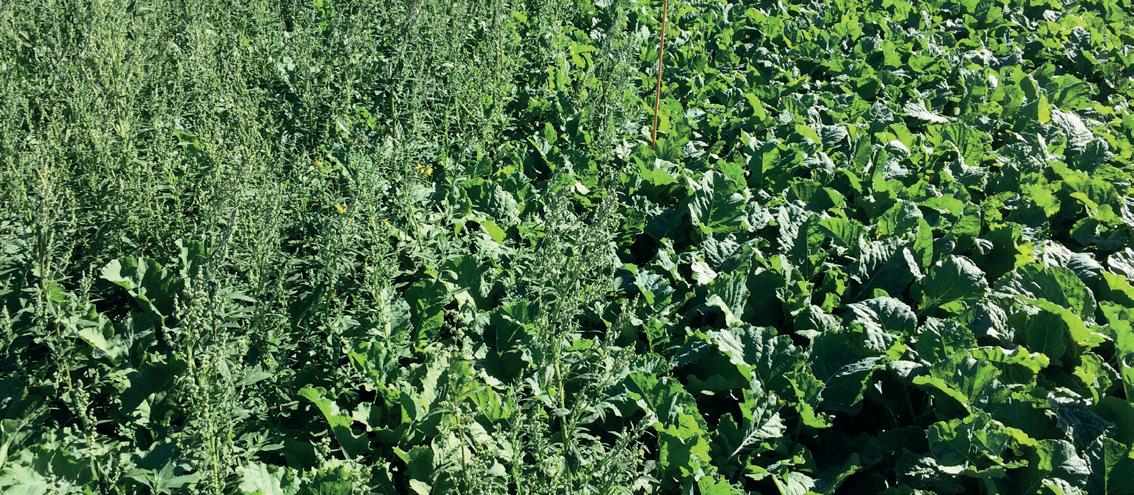
4 minute read
Successful weed control in forage brassicas
Weed control is important in forage brassicas both to minimise crop competition and to reduce the soil weed seed burden in advance of subsequent crops or pasture.
Forage brassicas are particularly susceptible to weed competition during establishment1. This is especially the case when sowing into scenarios with moderate to high weed seed loadings in the soil, such as previously cropped ground or run-out pastures with even just a low weed content. Cultivation can also bring long dormant weed seeds to the soil surface enabling germination within the crop. Three important weed control aspects worthy of focus in your forage brassica cropping plan include cultural control, spray out and seedbed preparation and the use of pre and post-emergent chemicals.
Cultural weed control
Agronomic practices that contribute to the rapid development of a dense brassica leaf canopy have an important role to play in providing cost-effective weed control. Aside from enhancing weed control, the pay-off is increased yield and quality forage for your livestock.
Areas to address include soil testing and correcting soil pH and fertility, preparing a quality seedbed, planting at appropriate soil temperatures and moisture, placing fertiliser down the spout at sowing (e.g. DAP), ensuring good seed to soil contact and monitoring early for pests to maintain plant population. These practices contribute to rapid germination, establishment and canopy cover ensuring the crop gets a head start on weeds and then shades them out.
| Fathen at ideal time to spray.
Sprayout and seedbed preparation
The principles involved here apply for both cultivated and direct drilling situations. An effective sprayout kills all existing vegetation including rhizomes and roots. This reduces seedbed trash and assists with preparation of good soil tilth for sowing and rapid germination2. The basis of this application, or applications, is typically glyphosate. A tank partner appropriate for any hard-to-kill broadleaf weeds present, with a residue profile appropriate for subsequent crops, may be warranted. Perennial weeds regrowing from root remnants e.g. dock, californian thistle or yarrow, can be difficult and more expensive to control selectively within the brassica crop, particularly under pre-emergence herbicide programmes and so are best dealt with at sprayout.
Pre and post-emergence weed control
Most brassica crops will still benefit from chemical weed control while the crop emerges and establishes. Effective control of weeds during brassica establishment relies on selecting a suitable approach for your scenario (pre or post-emergence programme) and then selecting herbicides that best fit the weed spectrum and crop rotation.
A pre-emergence herbicide programme may be suitable where you have a reliable understanding of the weed spectrum that will impact the crop, and can achieve the seedbed surface, incorporation or moisture activation requirements of the
| Treated vs untreated fathen.
specific chemical being considered. This offers the benefit of controlling weeds before they impact the crop, but it is a longer timeframe until the brassica reaches full canopy. It is important to get the pre-emergence approach right, particularly ensuring your weed spectrum is covered, while seedbed preparation and any incorporation is of a high standard. Post-emergence weed control is all about spraying if and when weeds emerge and selecting a herbicide that best matches the weed spectrum impacting the crop. One of the benefits here is this often coincides with the need to control early season brassica pests which can impact plant population e.g. Nysius, cutworm or springtail. Suitable chemistry is available to control a wide spectrum of annual and perennial broadleaf and grass weeds in brassicas. RadiateTM is ideal for controlling weeds such as fathen and nightshade. Korvetto™ provides control of the same key weeds but adds others such as fumitory, shepherds purse and Californian thistle while providing shorter plant backs and greater flexibility in crop rotations. The newly released Milestone™

controls the broadest spectrum of weeds including those that are hard to kill, such as spurrey, redroot, water pepper and seedling or regrowth perennials such as docks and Californian thistle. Application timing is key as best results are achieved when weeds are treated at the two to four leaf stage. Delaying application often leads to poor control of some harder to kill weeds, by which time they are already competing with the crop and will not be suppressed by canopy. Control emerged weeds early and get your brassica canopy doing the rest. Poor plant populations or crop establishment e.g. due to unforeseen pest damage or adverse weather events, often leads to a poor canopy and exposes the crop to weed pressure throughout the growing season. These scenarios require careful assessment so talk to your Farmlands Technical Field Officer as soon as possible for advice.
Monitor your crop
Timing is critical for successful weed and pest control in brassicas. Walk your crops regularly and thoroughly to identify issues early for timely treatment. When assessing your brassica crop for weeds or applying herbicides, consider the need or opportunity to control pests which may be present or are building up in the crop. Consider IPM options such as SpartaTM for springtail, leaf miner, white butterfly caterpillar and diamondback moth or Transform™ for aphids. LorsbanTM is suitable for a broad range of pests including Nysius and cutworm.
Always read the product label before using agricultural chemicals to ensure suitability for your situation and understand directions for use.
For more information, contact your Farmlands Technical Field Officer or the friendly team at your local Farmlands store.
References
1.
2. De Ruiter, J et al. 2009. Management practices for forage brassicas. Forage Brassica Development Group. pp38-40, Ritchie, B et al. 2000. Successful No-tillage in Crop and Pasture Establishment - A field manual for NZ farmers and contractors. CINTRE, Feilding, NZ. Pp37-39, 78.
Article supplied by Corteva Agriscience
®™ Trademarks of Dow AgroSciences, DuPont or Pioneer and their affiliated companies or respective owners.










